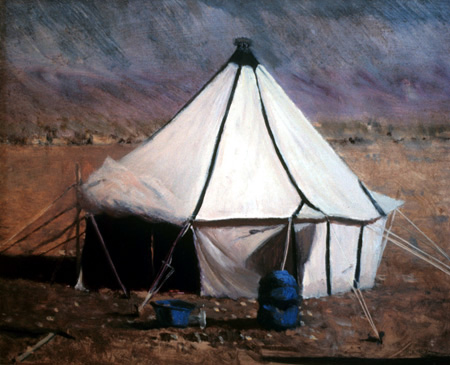Still thinking about those pesky brushstrokes as I painted today. I was constantly on the alert lest some brushstroke style arrive out of thin air.
I photographed some details for you today, but first I have some other things to mention. I'll intersperse the details. I hope you can find some value in them.
First, an artist friend and I were discussing the weight of all the paint in our plein air kits. To solve this problem we ordered 15ml empty collapsible tubes from Cheap Joe's.
Our regular tubes are either 37 or 40ml.
I, for one, never use very much paint when I'm outdoors (actually, I don't use much paint indoors, either). Anyway, even with a lot of brushing, 15ml of paint will last me for four or five days of plein air painting. So why lug all that extra paint around? The idea sounds great for air travel, too. Except I think the method has to be reversed. By this I mean you should take the original tubes, and half-empty them into the 15 ml tubes, leaving the 15ml tubes at home. I think TSA wouldn't like a bunch of white tubes with no official indication of their contents. Better to be prudent....
Susan Sanford commented about my brush-scrubbing on last night's post. Here's a photo covering a portion of the life span of some No. 8, Raphael series 358, round bristle brushes in my studio. I'm pretty sure I have some that are now just nubs, ready to draw with. But I couldn't quickly lay my hands on them. Thus the final stage of their lives is not represented in the photo.
I received a query from a very good painter who has ahead of her the task of stretching some very large canvases. Usually, up to a certain size, she works on canvas laid to panel. But these large ones will require being stretched on conventional bars. She admits that she's not very effective at stretching canvases, and asked for my advice. After ascertaining that she had good stretching pliers, I set about trying describe, pithily, what I do. (I now have great empathy for those in far off countries trying to write instructions in English for ones such as me to follow.)
Here's what I wrote, interrupted by some painting details:
Not sure how strong your hands are, but one
obviously has to get a death grip on the pliers to pull it tight.
Also, make sure you use the fulcrum on the
pliers to get that last bit of leverage. There's almost a 'click' as the fulcrum
snaps the canvas tight.
When I have time, I always lay the newly cut
piece of linen flat on the floor, upside down, before I stretch it. I think that some
time spent flat helps the canvas 'relax' from its rolled up state.
Also, I always stretch with the stretcher
frame standing on the floor, never laying it flat. I can't get enough leverage
when it's on a table, etc.
Yes, it's also true that sometimes a step-ladder is needed. Get yourself high enough on the ladder that the canvas edge is at your waist level. You'll need to do this to get enough leverage with your pliers. Obviously, if it's a step ladder, rather than a step stool, you'll want to have someone around when you do it.
Before I start, while the linen is still
relaxing on the floor, I lay the assembled stretcher bars on the canvas, and I
lightly scribe the canvas, along the stretcher's perimeter-----and I mean
LIGHTLY!---with a dull-pointed awl. Be careful not to scribe hard enough to
break the fibers. This will make it easier to get the canvas to turn the 90 degrees onto the plane
of the bars' edges.
This is followed by six on each long side
(three right of center, three left). Then the other long side.
I follow on by the same regimen on each
short side----then back to the long sides, and repeat.
When I've filled up the short sides, I take
out and replace the original staples at the ends.
Obviously, when I've filled up the long
sides, I remove the staples at the ends so I can make the corner
fold.
I generally leave a good bit of selvage,
tacking it flat on the back of the stretchers as a favor to myself, or for
someone else who may have to re-stretch the canvas in future.
I find, BTW, that after tediously removing
all the staples, re-stretching a canvas is always much easier than it was on the
original attempt.
I'm sure you're just itching to make a comment about the brushwork in these details. Perhaps you've found a common thread among them? I'd like to be among the first to know.
I had thought to play an April Fool's joke on you, but realized I was too tired to think of one. So I give you this link to an April Fool's post from last year (though not posted on 1 April).
Cheers,
Donald































